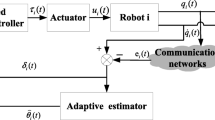Abstract
We consider a consensus control problem for a set of three-link manipulators connected by digraphs. Assume that the control inputs of each manipulator are the torques on its links and they are generated by adjusting the weighted difference between the manipulator’s states and those of its neighbor agents. Then, we propose a condition for adjusting the weighting coefficients in the control inputs, so that full consensus is achieved among the manipulators. By designing complex Hurwitz polynomials, we obtain a necessary and sufficient condition for achieving the consensus. Moreover, the discussion is extended to the case of designing convergence rate of consensus. Numerical examples are provided to illustrate the condition and the design conditions.
Similar content being viewed by others
References
Vicsek, T., Czirok, A., Ben-Jacob, E., Cohen, I., Shochet, O.: Novel type of phase transition in a system of self-driven particles. Phys. Rev. Lett. 75, 1226–1229 (1995)
Olfati-Saber, R., Fax, J.A., Murray, R.M.: Consensus and cooperation in networked multi-agent systems. Proc. IEEE 95, 215–233 (2007)
Huang, J.: Adaptive distributed observer and the cooperative control of multi-agent systems. J. Control Decis. 4(1), 1–11 (2017)
Shamma, J.: Cooperative Control of Distributed Multi-Agent Systems. Wiley, New York (2008)
Ren, W., Beard, R.W.: Distributed Consensus in Multi-Vehicle Cooperative Control: Theory and Applications. Springer, London (2008)
Ren, W., Beard, R.W.: Consensus seeking in multiagent systems under dynamically changing interaction topologies. IEEE Trans. Autom. Control 50(5), 655–661 (2005)
Ren, W., Beard, R.W., Atkins, E.: Information consensus in multivehicle cooperative control. IEEE Control Syst. Mag. 27(2), 71–82 (2007)
Fax, J.A., Murray, R.M.: Information flow and cooperative control of vehicle formations. IEEE Trans. Autom. Control 49, 1465–1476 (2004)
Jadbabaie, A., Lin, J., Morse, A.S.: Coordination of groups of mobile autonomous agents using nearest neighbor rules. IEEE Trans. Autom. Control 48, 988–1001 (2003)
Moreau, L.: Stability of multi-agent systems with time-dependent communication links. IEEE Trans. Autom. Control 50(2), 169–182 (2005)
Droge, G., Kawashima, H., Egerstedt, M.B.: Continuous-time proportional-integral distributed optimisation for networked systems. J. Control Decis 1(3), 191–213 (2014)
Sun, D., Wang, C., Shang, W., Feng, G.: A synchronization approach to trajectory tracking of multiple mobile robots while maintaining time-varying formations. IEEE Trans. Robot. 25(5), 1074–1086 (2009)
Sun, D.: Synchronization and Control of Multiagent Systems. CRC Press, Boca Raton (2010)
Bouteraa, Y., Abdallah, I.B.: Distributed control and speed sensorless for the synchronisation of multi-robot systems. Autom. Control. Comput. Sci. 50(5), 306–317 (2016)
Qin, J., Gao, H., Hayat, T., Alsaadi, F.E.: Synchronising second-order multi-agent systems under dynamic topology via reference model-based algorithm. J. Control Decis. 1(3), 214–225 (2014)
Yu, W., Chen, G., Cao, M.: Some necessary and sufficient conditions for second-order consensus in multi-agent dynamical systems. Automatica 46(6), 1089–1095 (2010)
Hou, W., Fu, M., Zhang, H., Wu, Z.: Consensus condition for general second-order multi-agent systems with communication delay. Automatica 75, 293–298 (2017)
Huang, C., Zhai, G., Xu, G.: Necessary and sufficient conditions for consensus in third order multi-agent systems, IEEE/CAA. J. Autom. Sinica 5(6), 1057–1066 (2018)
Xu, G., Huang, C., Zhai, G.: A necessary and sufficient condition for designing formation of discrete-time multi-agent systems with delay. Neurocomputing 315, 48–58 (2018)
Cheng, L., Hou, Z.G., Tan, M.: Decentralized adaptive consensus control for multi-manipulator system with uncertain dynamics. In: Proceedings of 2008 IEEE International Conference on Systems, Man and Cybernetics (SMC2008), Singapore, pp. 2712–2717 (2008)
Cui, R., Yan, W.: Mutual synchronization of multiple robot manipulators with unknown dynamics. J. Intell. Robot. Syst. 68(2), 105–119 (2012)
Zhao, D., Ni, W., Zhu, Q.: A framework of neural networks based consensus control for multiple robotic manipulators. Neurocomputing 140, 8–18 (2014)
Mohar, B.: The Laplacian Spectrum of Graphs. In: Alavi, Y., Chartrand, G., Ollermann, O., Schwenk, A. (eds.) Graph Theory, Combinatorics, and Applications, pp 871–898. Wiley, New York (1991)
Laub, A.J.: Matrix analysis for scientists and engineers. SIAM, Philadelphia (2004)
Murray, R.M., Li, Z., Sastry, S.S.: A Mathematical Introduction to Robotic Manipulation. CRC Prees, Boca Raton (1994)
Khalil, H.K.: Nonlinear Systems. 3rd edn. Prentice Hall, Englewood Cliffs (2001)
Frank, E.: On the zeros of polynomials with complex coefficients. Bull. Am. Math. Soc. 52, 144–157 (1946)
Hurwitz, A.: Über die Bedingungen unter welchen eine Gleichung nur Wurzeln mit negativen reellen Teilen besitzt. Math. Ann. 46, 273–284 (1895)
Xiong, L., Cheng, J., Cao, J., Liu, Z.: Novel inequality with application to improve the stability criterion for dynamical systems with two additive time-varying delays. Appl. Math. Comput. 321, 672–688 (2018)
Yu, W., Chen, G., Cao, M., Ren, W.: Delay-induced consensus and quasi-consensus in multi-agent dynamical systems. IEEE Trans. Circ. Syst. I 60(10), 2679–2687 (2013)
Acknowledgments
The authors would like to thank Professor Lianglin Xiong with Yunnan Minzu University for valuable discussion.
Author information
Authors and Affiliations
Corresponding author
Additional information
Publisher’s Note
Springer Nature remains neutral with regard to jurisdictional claims in published maps and institutional affiliations.
Appendix: Matrices in Dynamical System (3)
Appendix: Matrices in Dynamical System (3)
By using the joint angles 𝜃1, 𝜃2, 𝜃3 to compute h1(x), h2(x),h3(x) in V (x) and then substituting \(T(x, \dot {x})\), V (x) into the Lagrange’s equation, we obtain the dynamical (3).
To describe the matrices M(x), \(V(x, \dot {x})\) and G(x) in detail, we use the following shorthand notations
and let Ixi, Iyi, Izi be the moments of inertia about the x −, y −, and z −axes of the i th link frame. Then, M(x), \(V(x, \dot {x})\) and G(x) are as follows [25].
Manipulator inertia matrix M(x):
where
Coriolis matrix \(V(x,\dot {x})\):
where \(V_{ij} = v_{ij1}\dot {\theta }_{1} + v_{ij2} \dot {\theta }_{2} + v_{ij3} \dot {\theta }_{3}\) and
Gravity terms etc G(x):
Rights and permissions
About this article
Cite this article
Zhai, G., Nakamura, S. & Mardlijah A Unified Approach to Consensus Control of Three-Link Manipulators. J Intell Robot Syst 97, 3–15 (2020). https://doi.org/10.1007/s10846-019-01032-y
Received:
Accepted:
Published:
Issue Date:
DOI: https://doi.org/10.1007/s10846-019-01032-y



